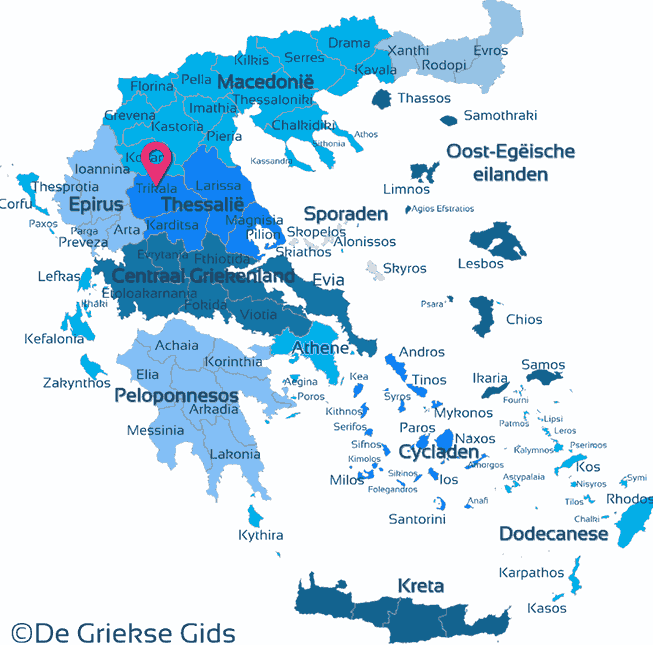Trikala - Thessaly (Greece)
Trikala. Trikala is one of the four prefectures of Thessaly. Trikala town is the capital of this prefecture. The town of Trikala has got its name from the nymph Trikki, the daughter of Pinios. Trikala is the third largest city in Thessaly with 75 000 residents. It’s also the birthplace of the first doctor without borders, Asclepeios (1247 BC). In the Middle Ages the name was used for first time. Once it was the seat of a Serb (14th century) and later of a Turkish prince. During the Turkish occupation it was the most important town in Thessaly.
The town is located on a great plain where the wind hardly blows, the consequence of it is very high temperatures in the summer. The temperatures can easily reach 40 degrees Celsius (104 degrees farenheit) or more.
Trikala town is the financial, cultural and tourist center of the prefecture of Trikala. It is an ideal place for a short break or for excursions. Litheos, the river, flows right through the town and ensures that the city has a special character. There are nice terraces, pretty squares and promenades. There are many important monuments such as the statue of Asclepeion, the castle, the mosque Kursum Tzami, the traditional neighborhood with mansions name Varousi, the post-Byzantine churches and the ethnological museum.
The most known sight of the prefecture is the world-famous Meteora. Very impressive are the Pindos mountain range with beautiful forests and rivers, Kalambaka, Pili, Elati, Pertouli, Aspropotamos and Kastraki.
There are a lot of cultural activities available in the region. Every summer, known Greek artists come to give concerts and all kind of exhibitions are organized. Summer festivals are held in almost every village. Very often people dressed in traditional costumes attend these events.
Trikala has a scenic landscape, there is a balance between mountains and plains. The climate is inconsistent, and temperatures can vary considerably. It always snows on the Pindos mountains in winter.
Trikala is an important regional trade center. It is also a fertile agricultural region where cotton is grown.
Photo Gallery Trikala - Photos of Thessaly
Sights Trikala
- The old Kusum-moskee from 1550, near the old road to Karditsa.
- Frourion (a 14th-century Byzantine fortress).
- The district near the Frourion, full of picturesque houses with all kinds of architectural oddities from the Turkish period, including one recently discovered with considerable historical value, which to be fully restored.
- The Byzantine castle.
- The archaeological site close to the metropolis of the city.
- The ethnological museum.
- The municipal art gallery.
- Pertouli. At a distance of 40 km (25 mi) from the town of Tikala there is a beautiful ski area, Pertouli. The ski area is open every day from December 1st to March 31st. There are a number of hotels and rooms to rent in the area of Pertouli.
- Koziaka. Koziaka the mountain and the river Acheloos are protected ecological areas. The area is great for walks.
- Avra. 12 km (7.5 mi) east of Kalambaka lies the village of Avra. The forest Koumaria is particularly beautiful with a nice view of Meteora and Trikala. The old church of St. Dimitrios of 1592 with its beautiful murals.
Text: Jorgos and Wendy Nikolidakis - Text edited by Katrina Butzer
Weather forecast Trikala
Trikala in other languages
 Trikala (GriekseGids.nl)
Trikala (GriekseGids.nl)
 Trikala (GriekseGids.be)
Trikala (GriekseGids.be)
 Trikala (GreeceGuide.co.uk)
Trikala (GreeceGuide.co.uk)
 Trikala (GriechenlandWeb.de)
Trikala (GriechenlandWeb.de)
Trikala: Where on the map is Trikala located?












